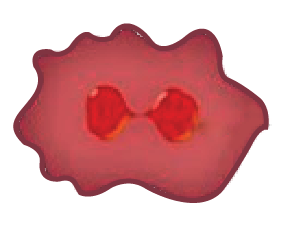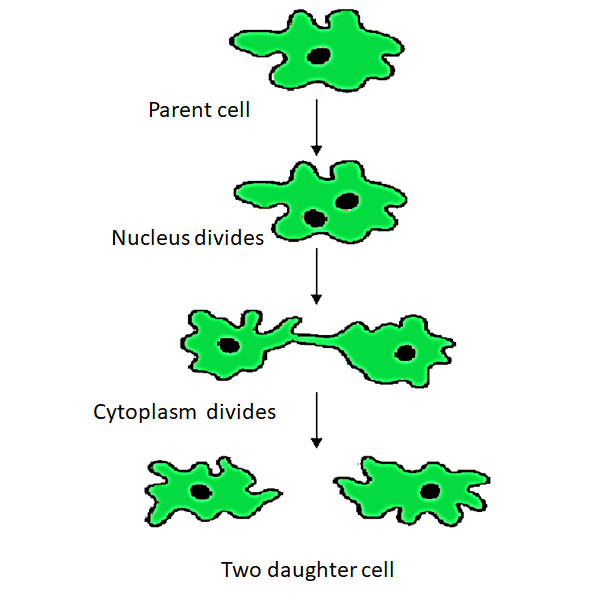
What does the figure represent?


Answer
485.7k+ views
Hint: Asexual reproduction refers to the formation of a new progeny without the union of gametes. Asexual reproduction is known as binary fission.
The amoeba divides into two halves, resulting in the formation of two daughter cells. In the process of asexual reproduction, the parent amoeba becomes a reproductive unit and continues to life as two daughter organisms.
Complete answer:
The figure represents binary fission in amoeba.
The binary fission process is used by amoeba to reproduce asexually. Binary fission is found in single-celled organisms of the Monera and Protista kingdoms (Amoeba and paramecium). The parent organism splits into two halves during this process, with each half creating an autonomous daughter organism. It means that the parent's entire body serves as the reproductive unit, and the parent lives on as two daughters.
Binary fission can be classified into the following categories, depending on the plane of division: Binary fission in its simplest form: Irregular binary fission is another name for it. A division can happen in any plane.
Amoeba, for example. Longitudinal Binary Fission: The plane of division runs parallel to the organism's longitudinal axis. For instance, in Bacteria, Paramoecium, and Diatoms, the plane of transverse binary division runs along the transverse axis of the individual.
Process of binary fission:
Step 1: The genetic material in the nucleus replicates during mitotic division during binary fission. By the process of karyokinesis, the nucleus initially divides into two daughter nuclei.
STEP 2: Next, cytokinesis occurs, in which the parent amoeba's cytoplasm separates into two daughter cells.
Each of the two daughter cells has its own nucleus and organelles.
STEP 3: Amoeba binary fission is irregular binary fission because cytokinesis can occur in any plane but is always perpendicular to the karyokinesis plane.
STEP 4: The cell creates proteins and nutrients during cytokinesis.
When conditions are good, such as when there is adequate food, water, and a sufficient temperature, binary fission occurs.

Note:
In binary fission, cell division is a mechanism of reproduction in and of itself.
It entails amitosis in bacteria and mitotic division of the nucleus in yeast and amoeba, i.e., cytokinesis (cytoplasm division) followed by cytokinesis in yeast and amoeba (a division of the nucleus).
In binary fission, the parent cell vanishes.
Binary fission does not have protuberance like budding.
The number of chromosomes in the daughter cells does not change. Mitochondria, for example, divide through binary fission.
The amoeba divides into two halves, resulting in the formation of two daughter cells. In the process of asexual reproduction, the parent amoeba becomes a reproductive unit and continues to life as two daughter organisms.
Complete answer:
The figure represents binary fission in amoeba.
The binary fission process is used by amoeba to reproduce asexually. Binary fission is found in single-celled organisms of the Monera and Protista kingdoms (Amoeba and paramecium). The parent organism splits into two halves during this process, with each half creating an autonomous daughter organism. It means that the parent's entire body serves as the reproductive unit, and the parent lives on as two daughters.
Binary fission can be classified into the following categories, depending on the plane of division: Binary fission in its simplest form: Irregular binary fission is another name for it. A division can happen in any plane.
Amoeba, for example. Longitudinal Binary Fission: The plane of division runs parallel to the organism's longitudinal axis. For instance, in Bacteria, Paramoecium, and Diatoms, the plane of transverse binary division runs along the transverse axis of the individual.
Process of binary fission:
Step 1: The genetic material in the nucleus replicates during mitotic division during binary fission. By the process of karyokinesis, the nucleus initially divides into two daughter nuclei.
STEP 2: Next, cytokinesis occurs, in which the parent amoeba's cytoplasm separates into two daughter cells.
Each of the two daughter cells has its own nucleus and organelles.
STEP 3: Amoeba binary fission is irregular binary fission because cytokinesis can occur in any plane but is always perpendicular to the karyokinesis plane.
STEP 4: The cell creates proteins and nutrients during cytokinesis.
When conditions are good, such as when there is adequate food, water, and a sufficient temperature, binary fission occurs.

Note:
In binary fission, cell division is a mechanism of reproduction in and of itself.
It entails amitosis in bacteria and mitotic division of the nucleus in yeast and amoeba, i.e., cytokinesis (cytoplasm division) followed by cytokinesis in yeast and amoeba (a division of the nucleus).
In binary fission, the parent cell vanishes.
Binary fission does not have protuberance like budding.
The number of chromosomes in the daughter cells does not change. Mitochondria, for example, divide through binary fission.
Recently Updated Pages
Two men on either side of the cliff 90m height observe class 10 maths CBSE

What happens to glucose which enters nephron along class 10 biology CBSE

Cutting of the Chinese melon means A The business and class 10 social science CBSE

Write a dialogue with at least ten utterances between class 10 english CBSE

Show an aquatic food chain using the following organisms class 10 biology CBSE

A circle is inscribed in an equilateral triangle and class 10 maths CBSE

Trending doubts
The shortest day of the year in India

Why is there a time difference of about 5 hours between class 10 social science CBSE

Write a letter to the principal requesting him to grant class 10 english CBSE

What is the median of the first 10 natural numbers class 10 maths CBSE

The Equation xxx + 2 is Satisfied when x is Equal to Class 10 Maths

What is the missing number in the sequence 259142027 class 10 maths CBSE




